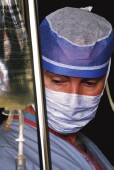 |
 |
 |
||
    |
||||
|
||||

Microsurgery May Cut Swelling After Breast Cancer Treatment
Technique reroutes lymphatic fluid to prevent buildup, experts explain|
|
HealthDay
By Kevin McKeever
Friday, March 27, 2009
 FRIDAY, March 27 (HealthDay News) -- Microsurgery can reduce the build-up of lymphatic fluid after breast cancer treatment, a new report shows.
FRIDAY, March 27 (HealthDay News) -- Microsurgery can reduce the build-up of lymphatic fluid after breast cancer treatment, a new report shows.
Lymphedema affects up to 30 percent of the women who have their lymph nodes removed or radiated as part of their breast cancer treatment, according to the National Cancer Institute. The swelling condition -- which can be chronic -- causes pain, weakness and a loss of flexibility.
Researchers at the University of Texas M. D. Anderson Cancer Center said they have been able to reduce the fluid build-up in women with lymphedema by 25 percent to 39 percent in a year with a lymphaticovenular bypass, a minimally invasive procedure that reroutes the fluid to vessels that are about a half-millimeter in diameter.
"Lymphedema is like a massive traffic jam with no exit," study author Dr. David W. Chang, director of the Plastic Surgery Clinic at M. D. Anderson, said in a news release issued by the cancer center. "This procedure does a lot to help relieve lymphedema by giving the fluid a way out."
The procedure does not eliminate the condition, Chang said, but "there is very little downside for the patient, and we may see significant improvement in its severity."
The findings were to be presented this week at the annual meeting of the American Association of Plastic Surgeons, in Rancho Mirage, Calif.
Almost any breast cancer patient with lymphedema could have the surgery, Chang said, though he added the best results would occur if it were done early in the disease, before the soft tissue of the affected arm hardens.
Surgical techniques previously used to treat lymphedema have not always been effective, Chang said. Most people rely on therapy such as massage, exercise and compression bandages to manage the condition and try to prevent complications.
The technique, which requires general anesthesia and an overnight stay in the hospital, could also be done on people with lymphedema in the legs, which is caused by pelvic cancers, he said. And, with refinement, it might prove applicable to lymphedema from the filariasis parasite, which affects 200 million people worldwide, he said.
"We have the potential to impact a large number of people," Chang said.
HealthDay
Copyright (c) 2009 ScoutNews, LLC. All rights reserved.
Related News:
More News on this Date
Related MedlinePlus Pages:
| Home | Health Topics | Drugs & Supplements | Encyclopedia | Dictionary | News | Directories | Other Resources | |
| Disclaimers | Copyright | Privacy | Accessibility | Quality Guidelines U.S. National Library of Medicine, 8600 Rockville Pike, Bethesda, MD 20894 National Institutes of Health | Department of Health & Human Services |
Date last updated: 30 March 2009 |
